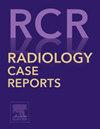Adult Type II diastematomyelia with tethered cord and associated spinal anomalies: A case report
Q4 Medicine
引用次数: 0
Abstract
Spinal dysraphism consists a group of congenital anomalies due to defective neural tube closure, among which diastematomyelia or split cord malformation is rare. Split cord malformation is classified into Type I and Type II, with Type II being less common and often asymptomatic. These anomalies may coexist with various spinal anomalies, as tethered cord, neural lipoma, hemimyelocele, and dorsal dermal sinus, forming a complex spectrum. Adult presentations are particularly uncommon and usually incidental. We herein report a 23-year-old male with chronic low back pain and a congenital midline lumbar swelling. Neurological examination and routine investigations were unremarkable. Magnetic resonance imaging revealed Type II diastematomyelia with two hemicords within a single dural sac from L4 to L5, low-lying conus medullaris, hemimyelocele with neural lipoma at L5-S1, tethered cord with filum terminale lipoma extending to S3-S4, and a dorsal dermal sinus tract. Despite the radiological complexity, the patient remained neurologically intact. Neurosurgical intervention was advised; however, the patient chose conservative management with close follow-up. This case highlights a rare adult presentation of complex spinal dysraphism with minimal symptoms. While diastematomyelia Type II is typically diagnosed in childhood, adult cases are infrequent and often delayed. Magnetic resonance imaging is crucial for diagnosis, particularly in asymptomatic individuals with cutaneous markers. Though surgery is generally recommended to prevent neurological decline, conservative management may be appropriate in selected stable cases. This case emphasizes the need to consider spinal anomalies in adults with chronic back pain and the importance of multidisciplinary evaluation.
成人II型脊髓纵裂伴脊髓栓系及相关脊柱异常1例报告
脊柱发育异常是一组由于神经管闭合缺陷而导致的先天性畸形,其中脊髓纵裂畸形或脊髓裂畸形较为少见。裂索畸形分为I型和II型,II型较少见,通常无症状。这些异常可与多种脊髓异常共存,如脊髓栓系、神经脂肪瘤、半脊髓膨出和背真皮窦,形成复杂的频谱。成人的表现尤其罕见,通常是偶然的。我们在此报告一个23岁的男性慢性腰痛和先天性腰中线肿胀。神经学检查及常规检查无显著差异。磁共振成像显示II型脊髓纵裂,在L4至L5的单个硬脊膜囊内有两条半脊髓,低处髓锥,半脊髓膨出伴L5- s1的神经脂肪瘤,脊髓系栓伴终丝脂肪瘤延伸至S3-S4,背真皮窦道。尽管放射学很复杂,但患者的神经系统完好无损。建议神经外科干预;患者选择保守治疗,密切随访。这个病例强调了一个罕见的成人复杂脊柱发育异常的轻微症状。虽然II型脊髓纵裂通常在儿童期被诊断出来,但成人病例并不常见,而且往往延迟。磁共振成像是诊断的关键,特别是在无症状的个体皮肤标记。虽然手术通常被推荐用于预防神经功能衰退,但在一些稳定的病例中,保守治疗可能是合适的。本病例强调需要考虑成人慢性背痛脊柱异常和多学科评估的重要性。
本文章由计算机程序翻译,如有差异,请以英文原文为准。
求助全文
约1分钟内获得全文
求助全文
来源期刊

Radiology Case Reports
Medicine-Radiology, Nuclear Medicine and Imaging
CiteScore
1.10
自引率
0.00%
发文量
1074
审稿时长
30 days
期刊介绍:
The content of this journal is exclusively case reports that feature diagnostic imaging. Categories in which case reports can be placed include the musculoskeletal system, spine, central nervous system, head and neck, cardiovascular, chest, gastrointestinal, genitourinary, multisystem, pediatric, emergency, women''s imaging, oncologic, normal variants, medical devices, foreign bodies, interventional radiology, nuclear medicine, molecular imaging, ultrasonography, imaging artifacts, forensic, anthropological, and medical-legal. Articles must be well-documented and include a review of the appropriate literature.
 求助内容:
求助内容: 应助结果提醒方式:
应助结果提醒方式:


